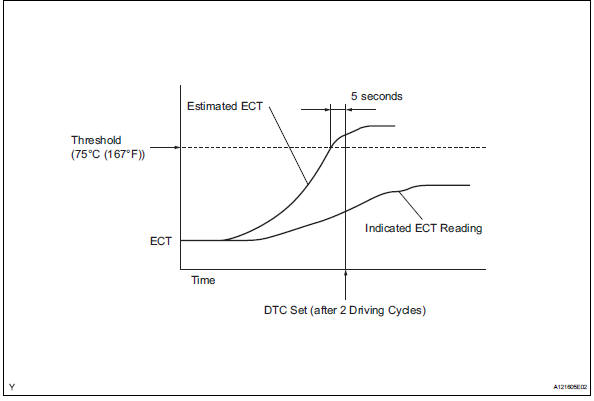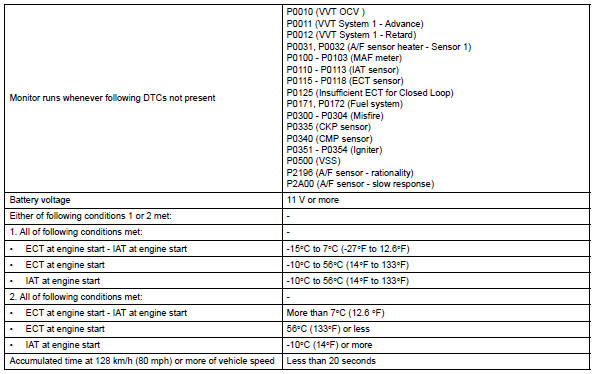Toyota RAV4 (XA40) 2013-2018 Service Manual: Coolant thermostat (coolant temperature below thermostat regulating temperature)

Hint:
This dtc relates to the thermostat.
Description
This dtc is set when the engine coolant temperature (ect) does not reach 75°c (167°f) despite sufficient engine warm-up time having elapsed.

Monitor description

The ecm estimates the ect based on the starting temperature, engine loads, and engine speeds. The ecm then compares the estimated temperature with the actual ect. When the estimated ect reaches 75°c (167°f), the ecm checks the actual ect. If the actual ect is less than 75°c (167°f), the ecm interprets this as a malfunction in the thermostat or the engine cooling system and sets the dtc.
Monitor strategy
![]()

Typical enabling conditions

Typical malfunction thresholds

Inspection procedure
Hint:
Read freeze frame data using the intelligent tester. Freeze frame data records the engine condition when malfunctions are detected. When troubleshooting, freeze frame data can help determine if the vehicle was moving or stationary, if the engine was warmed up or not, if the air-fuel ratio was lean or rich, and other data from the time the malfunction occurred.
- Check any other dtcs output (in addition to dtc p0128)
- Connect the intelligent tester to the dlc3.
- Turn the ignition switch on.
- Turn the tester on.
- Select the following menu items: diagnosis / enhanced obd ii / dtc info / current codes.
- Read dtcs.

Hint:
If any dtcs other than p0128 are output, troubleshoot those dtcs first.


- Check cooling system
- Check for defects in the cooling system that might cause the system to be too cold, such as abnormal radiator fan operation or any modifications.


- Inspect thermostat
- Remove the thermostat (see page co-15).
- Measure the valve opening temperature of the thermostat.
Standard value: 80 to 84°c (176 to 183°f)
Hint:
In addition to the above check, confirm that the valve is completely closed when the temperature is below the standard.
- Reinstall the thermostat (see page co-15).


 Insufficient coolant temperature for closed loop fuel control
Insufficient coolant temperature for closed loop fuel control
Description
Refer to dtc p0115 (see page es-105).
Monitor description
The resistance of the ect sensor varies in proportion to the actual ect. The
ect supplies a constant
voltage to the ...
 Oxygen sensor circuit
Oxygen sensor circuit
Description
In order to obtain a high purification rate of the carbon monoxide (co),
hydrocarbon (hc) and nitrogen
oxide (nox) components in the exhaust gas, a twc is used. For the most effici ...
Other materials:
Exhaust gas precautions
Harmful substance to the human body is included in exhaust
gases if inhale.
Caution
Exhaust gases include harmful carbon monoxide (co), which is colorless and
odorless. Observe the following precautions.
Failure to do so may cause exhaust gases enter the vehicle and may lead to
an accident c ...
Installation
Notice:
Do not heat the vehicle body, emblem and name plate
excessively.
Hint:
When installing the emblem and name plate, heat the vehicle
body, emblem and name plate using a heat light.
Standard heating temperature
Install no. 4 Back door name plate (for 4wd)
Clean the vehicle body ...
Defogging the windshield
Press .
The dehumidification function
operates and fan speed increases.
Set the outside/recirculated air
mode button to outside air mode if
the recirculated air mode is used.
(It may switch automatically.)
To defog the windshield and the
side windows early, turn the air
flow and t ...
